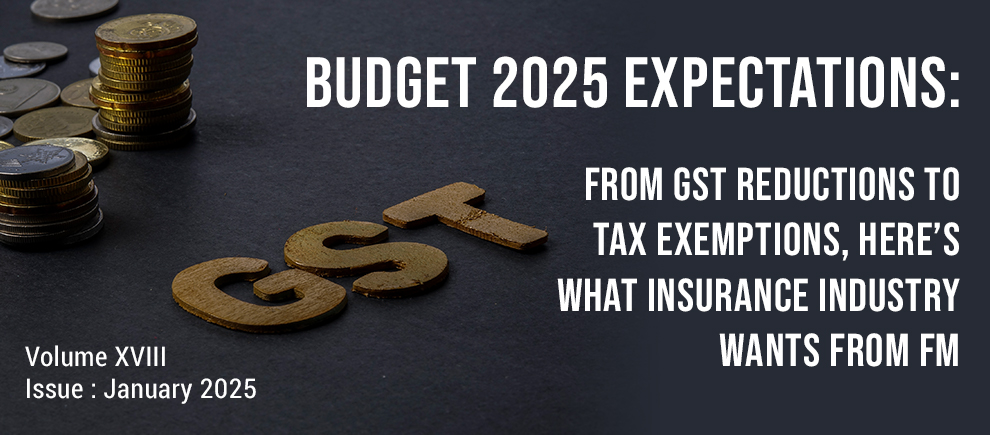TOPIC - Budget 2025 Expectations for Insurance Industry:
Budget 2025 Expectations: The insurance industry is hopeful for significant reforms that will enhance financial inclusion, address affordability challenges, and align India’s insurance practices with global standards.

1. Separate Tax Exemption for Term Insurance
Term insurance is a cornerstone of financial planning, offering essential life coverage at an affordable cost. However, the lack of a dedicated tax exemption for term insurance premiums often discourages individuals from opting for adequate coverage.
Term life insurance is most suited to a person for basic protection of his family’s financial future. It is the tool that makes sure that when you are not around, your loved ones will have a certain sum of money, which will enable them to bear the loss without having to worry about immediate income related problems.
“Introducing a separate tax category for term insurance would simplify financial planning and incentivize individuals to prioritize their family’s financial security. This reform could significantly narrow India’s protection gap, ensuring more households are safeguarded against unforeseen events,”
2. Reducing GST on Insurance Products
The current Goods and Services Tax (GST) rate of 18% on insurance premiums is a major barrier, particularly for low-income groups. High premiums, compounded by GST, make insurance products unaffordable for many. Reducing the GST rate would directly benefit policyholders, making insurance more accessible and affordable. This measure is critical to increasing penetration in underinsured segments, thereby fostering greater financial inclusion.
3. Enhancing Tax Deductions for Health Insurance
With rising healthcare costs, health insurance has become a necessity rather than a luxury. “Increasing the deduction limit under Section 80D to Rs 50,000 for individuals and Rs 1,00,000 for senior citizens would provide much-needed relief to policyholders. Additionally, introducing tax exemptions for contributions to Health Savings Accounts (HSAs) would offer further support in managing escalating medical expenses, ensuring that individuals can access quality healthcare without financial strain,”
4. Updating Rule 6E for Unexpired Premium Reserves
Rule 6E of the Income Tax Act currently allows only 50% of unexpired premium reserves for calculation, which is outdated and misaligned with modern financial practices. Shifting to the 1/365 method, already permitted by the Insurance Regulatory and Development Authority of India (IRDAI), would ensure fair risk management and bring India’s insurance sector in line with global standards.
5. Exempting Annuity Income from Taxation
Annuity products are a vital tool for retirement planning, yet the current tax structure discourages their adoption. Taxing both the annuity income and the principal creates a double burden for retirees. Exempting annuity income from taxation would encourage more individuals to invest in retirement- focused products, fostering financial security in their post-retirement years and reducing the burden on social welfare systems.
6. Addressing Medical Inflation with Pricing Consistency
Medical inflation, with hospitalization costs rising by as much as 15% in three years, poses a significant challenge for insurers and policyholders alike. The current system, which allows insurers to adjust product prices only once every three years, is insufficient to keep pace with inflation. Establishing pricing consistency at the hospital level, either through government intervention or the creation of a health regulator, is essential to mitigate the impact of medical inflation and ensure the sustainability of health insurance offerings.
7. Boosting Growth Through Investments and Innovation
Over the past nine years, India’s insurance sector has attracted $6.5 billion in investments, reflecting its growth potential. With 57 insurers operating in the country and a 100% Foreign Direct Investment (FDI) allowance, the sector has become increasingly competitive. To sustain this momentum, rationalizing GST rates and introducing tax incentives for innovation are crucial. These measures would not only attract further investments but also encourage the development of innovative products tailored to the needs of diverse customer segments.
8. Creating a Health Regulator
The establishment of a dedicated health regulator is a long-standing demand of the insurance industry. Such a regulator would oversee pricing mechanisms and standardize hospital costs, ensuring fair pricing and improving the affordability of health insurance products. This initiative would also enhance the sustainability of health insurance offerings, making them more accessible to a broader population.
9. Promoting Insurance Awareness and Adoption
Tax incentives have historically played a pivotal role in increasing insurance coverage in India. Further reforms to simplify processes and reduce costs would encourage more individuals to adopt insurance products, securing their financial well-being. Additionally, government-led awareness campaigns can help bridge the knowledge gap, ensuring that more Indians understand the importance of insurance and its role in financial planning.
Conclusion
“These measures would not only benefit policyholders but also contribute to the overall growth and stability of the Indian economy. As the insurance sector continues to evolve, proactive policy interventions will be key to ensuring that it remains a pillar of financial security for millions of Indians,”..
